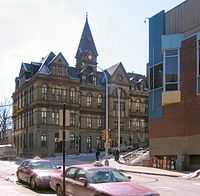Halifax City Hall
| Halifax City Hall | |
|---|---|
 Halifax City Hall, as seen from Grand Parade. | |
| General information | |
| Status | Complete |
| Architectural style | Late-Victorian Eclectic (Second Empire-influenced) |
| Location | Grand Parade |
| Address | 1841 Argyle Street |
| Town or city | Halifax, Nova Scotia |
| Country | Canada |
| Coordinates | 44°38′55″N 63°34′31″W / 44.64861°N 63.57528°W |
| Construction started | 1887 |
| Opening | May 22, 1890 |
| Owner | Halifax Regional Municipality |
| Design and construction | |
| Architect | Edward Elliot |
| Main contractor | Rhodes, Curry & Co. |
| Website | |
| www.halifax.ca/community/HalifaxCityHall/ | |
| Official name: Halifax City Hall National Historic Site of Canada | |
| Designated: | 1984/11/23 |
| Type: | Municipally Registered Property |
| Designated: | 1981/10/06 |
| Reference No. | 23MNS0448 |
Halifax City Hall is the seat of municipal government in Halifax Regional Municipality, Nova Scotia, Canada.
Since municipal amalgamation on 1 April 1996, Halifax City Hall has hosted the regular meetings of the Halifax Regional Council, as well as various municipal offices.
History

The building fronts Duke Street and is located at the north end of Grand Parade, an historic military parade square dating from the founding of Halifax in 1749.
Dalhousie University was situated on the present-day site of the building during the nineteenth century; for many years, the town and later city council argued for the public use of the site. A compromise was engineered by the premier, Sir William Young to facilitate a new use for the site. The provincial government provided funding for the university to relocate its facilities and the City of Halifax granted the university a 5-acre (20,000 m2) parcel of land elsewhere in the city to permit the university to expand. The university building was demolished to make way for the new structure and timbers from the old academic building were reportedly incorporated into the municipal building.
It was designed by Edward Elliot and constructed for the City of Halifax between 1887 and 1890; it is one of the oldest and largest public buildings in Nova Scotia and is a designated National Historic Site of Canada.[1] In 1981, it was also listed as a Municipally Registered Property under Nova Scotia's Heritage Property Act.[2]
Designed in an eclectic, monumental style, the building is of cream and red sandstone, laid in the freestone technique. It also features granite construction on the ground floor and in the tower. The seven-storey tower has clock faces on the north and south sides. The northern face, visible in the photograph (above right), is fixed at four minutes past nine to commemorate the Halifax Explosion of 1917.
Since municipal amalgamation in 1996, Halifax City Hall has become too small for the municipal government, thus the building is largely used to support councillors and their staff while municipal departments are located in adjacent commercial office space such as the Duke Tower (across the street) and Alderney Gate on the Dartmouth waterfront.
During the late 1990s, Halifax Regional Council attempted to have the building renamed from Halifax City Hall to Halifax Regional Hall, to reflect the fact that Nova Scotia no longer has any "cities"; this was promptly rejected after a public outcry among heritage advocates.
See also
External links
References
- ↑ Halifax City Hall National Historic Site of Canada. Canadian Register of Historic Places. Retrieved 9 February 2013.
- ↑ City Hall. Canadian Register of Historic Places. Retrieved 9 February 2012.
| ||||||||||||||